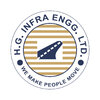Filter interviews by
Patel Engineering Civil GET Interview Questions and Answers
Patel Engineering Civil GET Interview Experiences
1 interview found
I applied via Campus Placement and was interviewed in Jan 2024. There were 2 interview rounds.
(2 Questions)
- Q1. ABOUT MY PROJECTS
- Q2. WHAT AE YOUR GOALS AN DO YOU SEE US IN IT
(4 Questions)
- Q1. ESTIMATION RELATED
- Q2. COMPONENTS OF DAMS
- Ans.
Components of dams include spillways, gates, reservoir, and embankment.
Spillways are structures that allow excess water to flow out of the dam.
Gates are used to control the flow of water through the dam.
Reservoir is the body of water created by the dam.
Embankment is the structure that holds back the water in the reservoir.
Other components may include intake structures, powerhouses, and fish ladders.
- Q3. PERSONALITY QUESTION , WHAT WILL I DO ON MY FIRST DAY AS GET
- Q4. BBS, EXCEL AND RCC BASIC
Interview Preparation Tips
Interview questions from similar companies

Moderate to easy. More theoretical in technical
Interview Preparation Tips

I applied via Company Website and was interviewed before Apr 2021. There were 7 interview rounds.
Accident, incident
Any hazardous
Any near miss
HIRA
Interview Preparation Tips
- Diploma Fire and Safety

Project Engineer Interview Questions & Answers
Simplex Infrastructuresposted on 29 Apr 2021
Interview Questionnaire
2 Questions
- Q1. Causes of accident
- Ans.
Accidents can be caused by various factors such as human error, equipment failure, environmental conditions, and lack of safety measures.
Human error: Mistakes or negligence by individuals involved in the project.
Equipment failure: Malfunction or breakdown of machinery or tools.
Environmental conditions: Adverse weather, natural disasters, or other external factors.
Lack of safety measures: Insufficient safety protocols o...
- Q2. 1. Unsufficient maintenance of machinery.
- Ans.
Insufficient maintenance of machinery can lead to breakdowns and production delays.
Regular maintenance schedules should be established and followed.
Proper training should be provided to operators and maintenance personnel.
Use of predictive maintenance techniques can help identify potential issues before they become major problems.
Examples: oil changes, lubrication, cleaning, calibration, inspections.
Failure to maintain...
Interview Preparation Tips

(2 Questions)
- Q1. Tell me about yourself.
- Q2. What are your strengths and weaknesses?

Project Engineer Interview Questions & Answers
Simplex Infrastructuresposted on 10 Nov 2021
Interview Questionnaire
1 Question
- Q1. They asked about previous experience and they asked me what’ are piling activities you followed let me explain that’s it
Interview Preparation Tips

Safety Officer Interview Questions & Answers
Simplex Infrastructuresposted on 20 Sep 2023
(1 Question)
- Q1. How you manage safety at site
- Ans.
I manage safety at site by conducting regular safety inspections, implementing safety protocols, providing safety training, and enforcing safety regulations.
Conduct regular safety inspections to identify potential hazards
Implement safety protocols to address identified hazards
Provide safety training to employees on proper safety procedures
Enforce safety regulations to ensure compliance
(2 Questions)
- Q1. Salary structure
- Q2. Not as per current environment
Interview Preparation Tips

Safety Officer Interview Questions & Answers
Simplex Infrastructuresposted on 18 Nov 2023

(1 Question)
- Q1. Salary Discussed
(2 Questions)
- Q1. What is Responsibility of Safety Officer
- Ans.
Safety Officer is responsible for ensuring the safety of employees, implementing safety protocols, conducting safety inspections, and promoting a culture of safety in the workplace.
Implementing safety protocols and procedures
Conducting safety inspections and audits
Training employees on safety practices
Investigating accidents and incidents
Ensuring compliance with safety regulations
Promoting a culture of safety in the wo
- Q2. Site Monetring. Training conducted Site Inspection Follow Legal Compliance Hazard identify and apply Suitable control measure to reduce hazard Tools Takles Inspection mock drill

I applied via LinkedIn and was interviewed in Aug 2022. There were 2 interview rounds.

(2 Questions)
- Q1. Tell us how would you behave in a difficult situation with a client
- Q2. Why do you want to work with us
Interview Preparation Tips

I applied via Company Website and was interviewed in Oct 2020. There were 4 interview rounds.
Interview Questionnaire
13 Questions
- Q1. What your experience
- Q2. Crust thickness
- Q3. How to cut 150 hill in 60 degree slope
- Ans.
Cutting 150 hill in 60 degree slope requires careful planning and execution.
Conduct a thorough survey of the area to determine the best approach
Use heavy machinery such as excavators and bulldozers to remove the hill
Ensure safety measures are in place to prevent accidents
Consider environmental impact and take necessary precautions
Consult with experts in the field for advice and guidance
- Q4. How we do Protection in 150m height
- Ans.
Protection in 150m height can be achieved through various means.
Use of safety harness and fall protection equipment
Installation of guardrails and safety nets
Implementation of a comprehensive safety plan
Regular inspection and maintenance of equipment
Training and education of workers on safety procedures
- Q5. Which grade of bitumin used in hill area
- Ans.
The grade of bitumen used in hill areas depends on the temperature and altitude of the region.
The higher the altitude, the harder the bitumen used.
The temperature also plays a crucial role in determining the grade of bitumen.
For example, in colder regions, a harder grade of bitumen is used to prevent cracking and deformation.
In contrast, in warmer regions, a softer grade of bitumen is used to prevent rutting and deform
- Q6. How do we concrete in min temp
- Ans.
Concrete in minimum temperature requires proper mix design, curing, and protection from freezing.
Use a mix design with low water-cement ratio and proper amount of cement and admixtures.
Ensure proper curing by covering the concrete with blankets or insulating materials.
Protect the concrete from freezing by using heaters or insulating blankets.
Monitor the temperature of the concrete and the environment during and after p...
- Q7. How do we protect cavity in tunnel
- Ans.
Cavity in tunnels can be protected by using various methods.
Waterproofing the tunnel lining
Using grouting techniques to fill the cavity
Installing drainage systems to prevent water accumulation
Regular inspections and maintenance
Using shotcrete to reinforce the tunnel lining
Applying rock bolts to stabilize the surrounding rock
Using steel ribs to support the tunnel lining
- Q8. Cycle time in tunnel
- Ans.
Cycle time in tunnel refers to the time taken to complete one cycle of a process or operation within the tunnel.
Cycle time can vary depending on the type of tunnel and the process being carried out.
For example, in a transportation tunnel, cycle time may refer to the time taken for a vehicle to enter and exit the tunnel.
In a manufacturing tunnel, cycle time may refer to the time taken to complete one production cycle.
Ef...
- Q9. NATM full form
- Ans.
NATM stands for New Austrian Tunneling Method, a technique used in underground construction.
NATM is a tunneling method that involves excavating the tunnel while providing support to the surrounding rock mass.
It was developed in Austria in the 1950s and has since been used in various tunneling projects worldwide.
NATM involves the use of shotcrete, rock bolts, and steel ribs to support the tunnel walls and roof.
Examples ...
- Q10. How much we drill holes in face
- Ans.
The frequency of drilling holes in the face depends on the specific project requirements and geological conditions.
The number of holes drilled in the face will vary depending on the project's needs and the geological conditions of the site.
Factors such as the type of rock, the size of the excavation, and the equipment being used will all influence the frequency of drilling.
It is important to carefully plan and execute ...
- Q11. What is proholes and what it's uses
- Ans.
Proholes is not a known term in engineering. No data available.
- Q12. Why is drain holes we do
- Ans.
Drain holes are necessary to prevent water accumulation and damage to structures or equipment.
Drain holes allow water to escape from areas where it can cause damage or corrosion.
They are commonly used in outdoor furniture, boats, and buildings to prevent water accumulation.
Drain holes can also be used in machinery to prevent damage from water or other liquids.
Proper placement and size of drain holes is important to ens
- Q13. How much asscelerate we used in shotcrete
- Ans.
The amount of accelerator used in shotcrete depends on various factors.
The type of accelerator used affects the amount required.
The desired strength and setting time also play a role.
The ambient temperature and humidity can affect the amount needed.
Typically, 1-5% of the cement weight is used as accelerator.
The manufacturer's recommendations should be followed for best results.
Interview Preparation Tips
Patel Engineering Interview FAQs
Tell us how to improve this page.
Patel Engineering Interviews By Designations
- Patel Engineering Project Engineer Interview Questions
- Patel Engineering Safety Officer Interview Questions
- Patel Engineering Store Head Interview Questions
- Patel Engineering Project Engineer - Civil Interview Questions
- Patel Engineering Workman/Foreman/Technician Interview Questions
- Patel Engineering Engineer Interview Questions
- Patel Engineering Electrical Engineer Interview Questions
- Patel Engineering Site Engineer Interview Questions
- Show more
Interview Questions for Popular Designations
- Civil Site Engineer Interview Questions
- Civil Engineer Interview Questions
- Senior Civil Engineer Interview Questions
- Junior Engineer Civil Interview Questions
- Civil Foreman Interview Questions
- Civil Supervisor Interview Questions
- Project Engineer - Civil Interview Questions
- Assistant Engineer - Civil Interview Questions
- Show more
Patel Engineering Civil GET Interview Process
based on 1 interview
Interview experience
Interview Questions from Similar Companies
|
Project Engineer
142
salaries
| ₹3.6 L/yr - ₹9.9 L/yr |
|
Assistant Manager
74
salaries
| ₹5.5 L/yr - ₹13.4 L/yr |
|
Civil Engineer
63
salaries
| ₹2.9 L/yr - ₹6.6 L/yr |
|
Mechanical Engineer
43
salaries
| ₹1.8 L/yr - ₹7.2 L/yr |
|
Surveyor
34
salaries
| ₹2.4 L/yr - ₹6.6 L/yr |

L&T Construction

Simplex Infrastructures

ITD Cementation India

Ashoka Buildcon
- Home >
- Interviews >
- Patel Engineering Interview Questions >
- Patel Engineering Civil GET Interview Questions

















